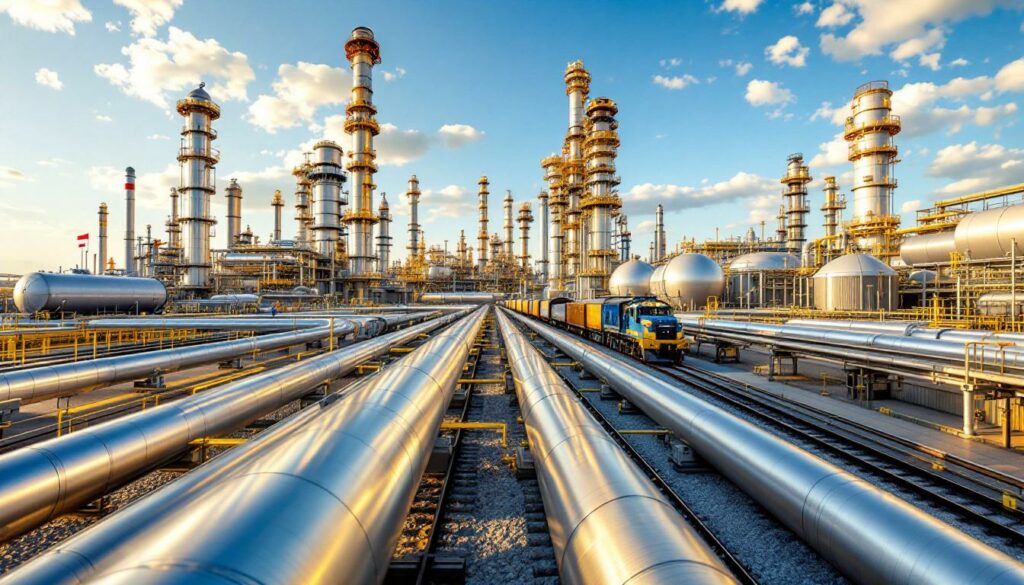Kazakhstan's Bold Energy Strategy: Tripling Fuel Exports by 2040
Kazakhstan has unveiled an ambitious plan to transform its energy sector by tripling petroleum product exports over the next 15 years. The sweeping 2025-2040 strategy represents a dramatic shift from the nation's traditional focus on crude oil exports toward higher-value refined products and petrochemicals. This strategic pivot aims to maximize economic returns from Kazakhstan's substantial hydrocarbon reserves while reducing vulnerability to volatile oil price rally impact.
The government-approved plan will see exports rise from the current 17 million tons annually to an impressive 39 million tons by 2040, with export volumes growing from 10% to 30% of total refined production. This marks a fundamental departure from previous policy frameworks that had capped fuel exports at just 10% of output.
How Kazakhstan Plans to Triple Fuel Exports by 2040
The Scale of Kazakhstan's Energy Transformation
Kazakhstan's ambitious strategy involves a comprehensive overhaul of its downstream sector. The transformation centers on increasing both refining capacity and sophistication, enabling the country to process more of its crude oil domestically while producing higher-value products for export markets.
"This marks a watershed moment for Kazakhstan's energy sector," noted Energy Minister Almasadam Satkaliyev in a recent press briefing. "By tripling our fuel exports to 39 million tons annually, we're positioning Kazakhstan as a major player in the Eurasian refined products market."
The export growth will be carefully balanced with domestic needs, as the strategy incorporates projected 1.5-2% annual growth in local fuel consumption. The plan ensures Kazakhstan maintains complete self-sufficiency in petroleum products while substantially increasing export volumes.
$20 Billion Investment in Downstream Infrastructure
The cornerstone of Kazakhstan's strategy is approximately $20 billion in total investments across the refining and petrochemical sectors:
- $15 billion allocated to six major refining projects already underway
- $5 billion dedicated specifically to petrochemical development
- Focus on increasing refining depth to 94%, enabling more valuable product yields
- Modernization of existing facilities and construction of new processing capacity
According to The Times of Central Asia, "Kazakhstan will invest up to $5 billion in its oil and gas chemical sector, focusing on polymers, fertilizers, and other high-value products." This investment complements the government's broader downstream development vision and positions the country to capture more value from its hydrocarbon resources.
The technical improvements will bring Kazakhstan's refineries closer to world-class standards. The targeted refining depth of 94% represents a significant advance in processing sophistication, allowing refineries to convert more of each barrel into premium products like gasoline, diesel, and petrochemical feedstocks while minimizing production of lower-value heavy fuel oil.
Strategic Market Targeting
Kazakhstan's export strategy prioritizes three key growth markets with strategic advantages:
- China: Leveraging geographic proximity and established pipeline connections to tap into China's massive and growing energy demand
- India: Positioning to supply one of the world's fastest-growing fuel consumers through developing transportation corridors
- Central Asian neighbors: Strengthening regional energy integration and trade relationships with nearby countries
These target markets offer complementary opportunities. China provides immediate access via existing infrastructure, while India represents a high-growth market with strong long-term potential. Regional Central Asian markets offer shorter supply chains and established trade relationships.
"Kazakhstan's strategic location at the crossroads of Europe and Asia provides natural advantages for reaching diverse markets," notes energy analyst Elena Karimova. "The country can leverage existing transport corridors while developing new routes to maximize its export potential."
What Makes Kazakhstan's New Strategy Different?
Shift from Raw Exports to Value-Added Products
Kazakhstan's revised approach represents a fundamental reorientation of its energy sector strategy:
- Previous focus: Primarily exporting crude oil with limited domestic processing
- New direction: Expanding downstream capabilities to capture more value from hydrocarbon resources
- Economic diversification: Reducing dependence on raw commodity exports
- Market resilience: Creating buffers against oil market trade wars
This strategic shift mirrors successful models implemented in other resource-rich nations like Saudi Arabia and the UAE, which have invested heavily in refining and petrochemical capacity to reduce economic vulnerability to crude price fluctuations.
The value proposition is compelling: a barrel of crude oil processed into refined products and petrochemicals can generate 2-3 times more revenue than exporting the raw crude. This value addition creates more jobs, develops technical expertise, and generates more stable revenue streams.
Comprehensive Petrochemical Development
The $5 billion petrochemical investment will focus on developing integrated production capacity for:
- Polymer production: Including polyethylene, polypropylene, and specialty polymers
- Fertilizer manufacturing: Leveraging natural gas feedstock for nitrogen-based fertilizers
- High-value specialty chemicals: Targeting niche markets with premium products
- Integration with refining operations: Maximizing feedstock efficiency and operational synergies
Kazakhstan's petrochemical push addresses both export opportunities and domestic manufacturing needs. Locally produced polymers and chemicals can support the development of downstream manufacturing industries within Kazakhstan, creating additional economic benefits beyond direct export revenues.
Domestic Demand Considerations
While pursuing export growth, the strategy carefully addresses domestic market needs:
- Planning for 1.5-2% annual growth in domestic fuel consumption
- Ensuring complete self-sufficiency in refined products
- Accommodating increased demand from urbanization and industrial development
- Maintaining strategic reserves for energy security
The balanced approach ensures Kazakhstan can meet domestic requirements while maximizing export potential. The strategy includes supply chain optimizations to improve domestic distribution efficiency and reduce regional price disparities within the country.
What Resources Support Kazakhstan's Ambitious Plans?
Substantial Oil Reserves Base
Kazakhstan's strategy is underpinned by its significant hydrocarbon resources:
- 30 billion barrels of proven oil reserves
- Positioning as one of Central Asia's most resource-rich nations
- Long-term production potential to sustain refining expansion
"The Energy Ministry emphasized that with 30 billion barrels of proven reserves, Kazakhstan intends to become a strategic refining center in Eurasia," reported Astana Times. These substantial reserves provide the foundation for decades of refining operations and petrochemical production.
Kazakhstan's reserves rank among the top 15 globally, providing confidence that the country can maintain sufficient crude oil production to feed its expanding downstream sector while continuing some level of crude exports.
Geographic Advantages for Export Markets
The country's strategic location provides natural advantages for its export ambitions:
- China border: Direct pipeline and rail connections to the world's largest energy importer
- Access to India: Developing transportation corridors through neighboring countries
- Central position: Hub location in Eurasian energy networks
- Multiple route options: Flexibility to reach diverse markets
Kazakhstan's position at the crossroads of Europe and Asia allows it to pivot between markets based on demand conditions and pricing opportunities. While the country is landlocked, it has developed diverse export routes and continues to expand its transportation options.
How Will Implementation Proceed?
Phased Development Approach
The implementation timeline follows a structured progression:
- Initial phase (2025-2027): Launch of pilot digitization initiatives and efficiency improvements
- Expansion phase (2028-2032): Sequential capacity additions and process optimization
- Export growth phase (2033-2037): Development of specialized export infrastructure
- Full capacity phase (2038-2040): Achievement of 39 million ton export target
According to industry publication ICE, the implementation begins in 2025 with pilot refinery digitization initiatives designed to improve operational efficiency and attract investment. The phased approach allows Kazakhstan to build on successes incrementally while managing investment requirements.
Technology and Efficiency Improvements
The strategy emphasizes technological advancement as a key enabler:
- Refinery digitization: Implementation of advanced process control and optimization systems
- Process optimization: Maximizing product yields through improved conversion technologies
- Energy efficiency: Reducing production costs through lower energy consumption
- Environmental technology: Meeting international sustainability standards
These technological improvements will bring Kazakhstan's refineries closer to world-class performance metrics while reducing environmental impact. Digital technologies will enhance operational visibility, improve maintenance planning, and optimize throughput.
What Challenges Must Kazakhstan Overcome?
Infrastructure Development Requirements
Successful implementation will require significant infrastructure improvements:
- Export pipeline capacity: Expansion of existing networks and potential new routes
- Rail and transportation: Enhancement of rolling stock and loading facilities
- Storage and terminals: Development of strategic buffer capacity at border crossings
- Port access arrangements: Securing reliable routes to seaborne markets
The infrastructure investments must be carefully sequenced to align with refining capacity growth. Kazakhstan will need to coordinate closely with neighboring countries on cross-border infrastructure projects and transit agreements.
Regional Competition Considerations
Kazakhstan faces competition from other regional refiners:
- Russian refineries: Established export channels and reputation for reliability
- Middle Eastern producers: Expanding downstream sectors with world-scale facilities
- Chinese domestic capacity: Growing self-sufficiency in China's refining sector
- Emerging Central Asian producers: New competitive pressures in regional markets
Differentiating Kazakhstan's products through quality specifications, reliability, and competitive pricing will be essential to securing market share in target export destinations.
Financing and Investment Attraction
The ambitious investment requirements will necessitate diverse funding sources:
- Foreign direct investment: Partnerships with international energy companies
- International financing: Loans from development banks and export credit agencies
- Joint ventures: Collaborative projects with technology providers and market participants
- Offtake agreements: Long-term supply contracts to secure revenue streams
Kazakhstan will need to create an attractive investment climate with regulatory stability, transparent processes, and competitive fiscal terms to mobilize the required capital.
What Are the Economic Implications?
Value Addition to Kazakhstan's Economy
The downstream expansion strategy offers substantial economic benefits:
- Higher-value exports: Premium pricing for refined products versus crude oil
- Job creation: Thousands of technical and specialized roles throughout the value chain
- Skills development: Building domestic expertise in high-value industrial processes
- Expanded tax base: Increased government revenues from value-added products
According to economic analysis by the Astana International Financial Centre, each dollar invested in downstream capacity can generate approximately $3-4 in economic value over the project lifetime when considering direct, indirect, and induced economic effects.
Reduced Economic Volatility
By diversifying into refined products, Kazakhstan aims to create more stable economic conditions:
- Buffer against crude price fluctuations: Refined product margins often move independently from crude
- More stable revenue streams: Diverse product portfolio reduces concentration risk
- Counter-cyclical opportunities: Different market dynamics across product categories
- Predictable budget forecasting: Less vulnerability to extreme oil price swings
This economic stabilization effect is particularly valuable for Kazakhstan, where hydrocarbon revenues have historically constituted a significant portion of government budgets and export earnings.
How Does This Strategy Align With Regional Trends?
Part of a Broader Eurasian Refining Expansion
Kazakhstan's strategy reflects a regional trend in energy development:
- Multiple Eurasian nations: Pursuing downstream investment and capacity growth
- Shifting trade patterns: Evolving from crude exports to product exports
- Regional integration: Increased cross-border energy infrastructure
- Self-sufficiency goals: Reduced dependence on imported refined products
Countries across the Eurasian region are making similar strategic shifts, creating both competition and opportunities for regional cooperation in specialized product markets.
Positioning in China's Energy Security Framework
The strategy aligns with China's energy security priorities:
- Supply diversification: Reducing China's dependence on maritime energy routes
- Land-based supply corridors: Development of secure overland connections
- Belt and Road Initiative: Complementary to China's regional development vision
- Long-term partnerships: Potential for stable supply relationships
Kazakhstan's proximity to western China positions it as a natural supplier to China's rapidly developing western regions, where energy demand continues to grow alongside industrial development.
FAQs About Kazakhstan's Fuel Export Strategy
How does Kazakhstan's strategy compare to other oil-producing nations?
Kazakhstan's approach mirrors successful models implemented by other resource-rich countries that have diversified beyond raw exports. While many oil producers remain primarily focused on crude exports, Kazakhstan joins nations like Saudi Arabia and the UAE in pursuing significant downstream value addition. The 30% export target represents a middle ground between export-focused models and domestically-oriented refining sectors.
What environmental considerations are included in the strategy?
The strategy incorporates modernization elements that will improve environmental performance through higher efficiency operations, reduced emissions intensity, and better product specifications. The increased refining depth target of 94% will minimize production of lower-value, higher-impact heavy products in favor of cleaner transportation fuels and petrochemical feedstocks.
How might geopolitical factors affect implementation?
Kazakhstan's landlocked position requires careful navigation of transit relationships with neighboring countries. The strategy's success depends on maintaining positive diplomatic relations with transit nations, particularly Russia and China. Diversification of export routes will be crucial to mitigate potential geopolitical tensions impact and ensure reliable access to target markets.
What role will international partnerships play?
International technology providers, investors, and market participants will be essential to the strategy's success. Kazakhstan will likely pursue joint ventures with experienced refining and petrochemical operators to access advanced technologies, operational expertise, and established marketing channels. These partnerships will accelerate development timelines and reduce implementation risks.
Will the strategy impact global energy markets?
While significant for Kazakhstan, the strategy is unlikely to fundamentally reshape global energy markets. The additional 22 million tons of refined product exports represent less than 1% of global refined product demand. However, the strategy could have meaningful impacts on regional market dynamics, particularly in Central Asia and western China, where Kazakhstan's exports may displace other suppliers. Furthermore, the initiative may create new investment opportunities 2025 in the energy sector as the country develops its infrastructure.
Kazakhstan's fuel export strategy represents a comprehensive approach to energy sector development that balances domestic needs with export opportunities. By investing $20 billion in downstream capacity and targeting triple the current export volumes by 2040, Kazakhstan aims to transform its position in regional energy markets while creating a more stable and diversified economic base that can withstand potential global tariffs impact.
Ready to Discover the Next Major ASX Mineral Discovery?
Don't miss potential market-moving announcements – Discovery Alert's proprietary Discovery IQ model provides instant notifications on significant ASX mineral discoveries, turning complex data into actionable insights for investors. Visit the Discovery Alert discoveries page to understand why historic discoveries can generate substantial returns, and begin your 30-day free trial today.




